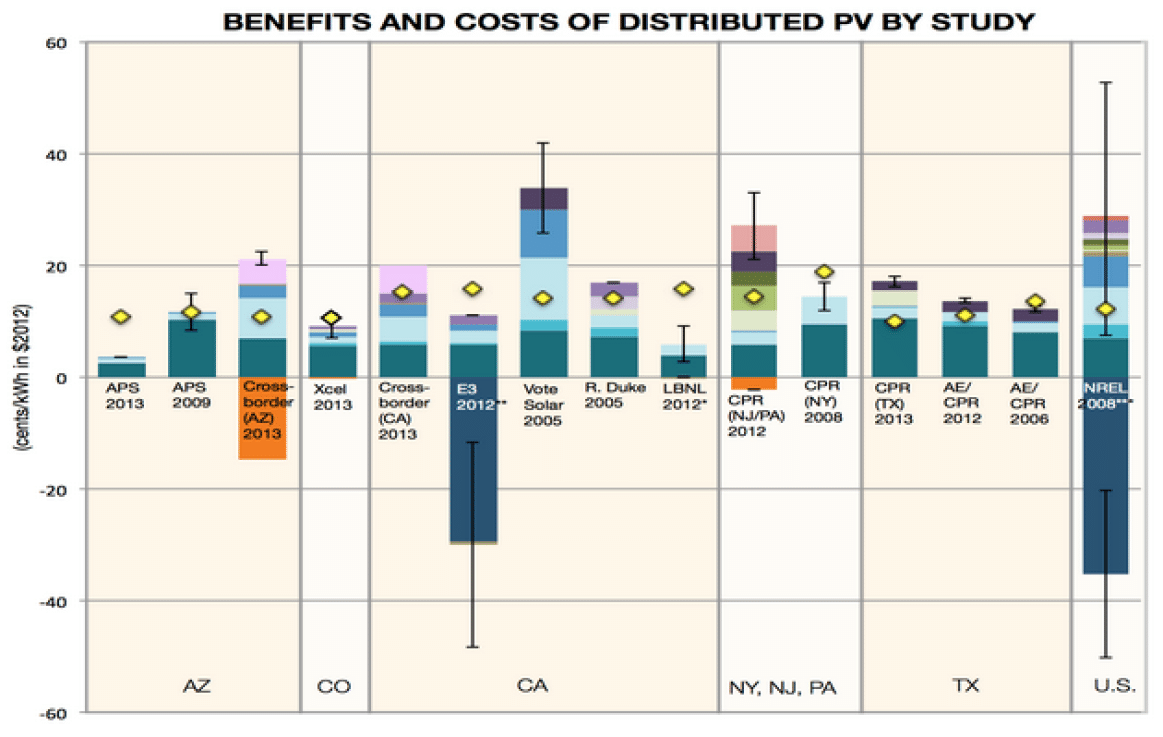
As net energy metering (NEM) caps across the country begin to approach their legislative quotas many states have no choice but to reevaluate their solar policy landscape. Although there is little doubt of the effectiveness of NEM in proliferating the spread of solar PV, at high levels of grid penetration static NEM rates fail to accurately price solar energy into the grid. Under these conditions NEM rates may overcompensate solar PV as installed cost of solar declines. Ultimately, to properly inform future energy policy it is crucial to accurately assess the value of solar energy to the grid.
The value of solar to the grid is constituted by a sum of avoided costs plus net social benefits to society minus costs imparted on the grid of PV integration. The first and most significant value of solar comes from the avoided cost of energy that PV displaces. The value represent savings from fuel that would have otherwise been consumed. These savings are most significant during times of peak demand as utilities move up the merit order of generators to meet demand. Deferring to solar production during these periods removes the needs to activate these higher cost generators. Locally generated solar energy also minimizes the impact of efficiency losses in the transmission and distribution grid, lowering the overall amount of energy required to meet demand. In Massachusetts the avoided energy cost associated with PV production is valued over $.05 per kWh while in Maine this service is valued closer to $.08 per kWh.

Along the same lines as avoided energy is avoided capacity costs. Although PV is fundamentally variable in the short-term, over longer time horizons solar production is reasonably predictable. This allows for centralized fossil generation capacity to be gradually drawn down. Along similar lines distributed PV can reduce the congestion and capacity strains on transmission and distribution infrastructure. As capacity requirements fall, costs associated with upgrading or expanding infrastructure can be credited to the value of solar. Significant solar capacity may also limit the need to invest in natural gas pipeline expansions. Finally, the integration of distributed energy storage with PV stands to increase the value of solar even further. When paired, these two resources reduce peak demand on the grid when costs are highest in addition to delivering a myriad of other grid services such as frequency control, reactive power supply, energy imbalance and operating reserves.
Lastly, decreased energy and capacity requirements lower the costs associated to emission compliance at centralized generators. In addition to buying permits for the release of NOx and SO2, some states mandate emission control devices such as scrubbers to minimize the impact of coal and natural gas combustion. By displacing this generation with PV less permits need to be purchased. Furthermore, although far more challenging to quantify, significant societal benefits can derived from a decrease in NOx, SO2 and CO2 emission from generators.
Unfortunately it is extremely challenging to assign precise values to many of these metrics as they vary regionally and temporally as solar capacity grows. The value of solar further depends on the orientation, tilt and potential tracking abilities of a given array. It also must be mentioned that in the absence of considerable storage capacity large levels of PV penetration can increase potential costs to the grid to maintain the balance between supply and demand. However, if the services supplied by distributed PV, such as those mentioned above, outweigh the grid services required to maintain a given solar capacity net positive benefits will be realized.